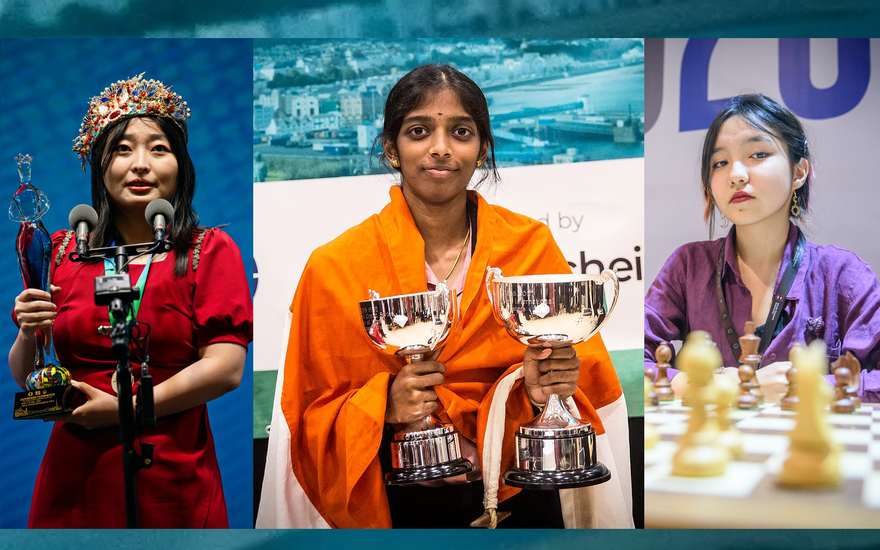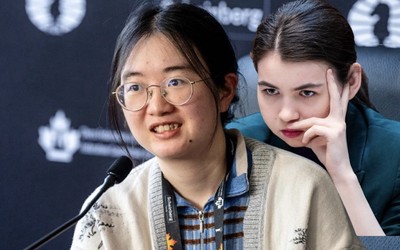
FIDE / Stev Bonhage, Anna Shtourman, Michal Walusza
Women's Chess in Asia: 2023 Year-in-Review
Look out, here comes India!For the last three decades and counting, women’s chess in Asia has been synonymous with one thing: China. China has dominated the Women’s World Championship with six different champions claiming 15 of the last 20 titles. China has been the only Asian country to win the Women’s Chess Olympiad, which they have done six times in the last twelve editions. And China has produced the most GMs of any country in the world with ten, the only country in Asia with multiple GMs besides India who only just got to three.
But all of that is about to change! Not because China isn’t the best anymore (they still are!), but because now India is coming. And Asia has absorbed Russia. And even the relatively small Kazakhstan could be shaping up to be a huge power in the years to come.
China
There shouldn’t be any doubt China is No. 1 because both of this past year’s World Championship match participants, world champion Ju Wenjun and the challenger Lei Tingjie, were from China. Even the previous world champion Tan Zhongyi is still active and at her best. And Zhu Jiner became the most recent woman to receive the GM title this past year, and she’s only 21.
Ju Wenjun proved she’s still at a 2600+ level with her 2680 performance at the Sharjah Masters, the year’s best among women, and then by winning the World Championship over Lei Tingjie, who herself was playing at a 2600+ level in the lead-up to their match. The match was perhaps the highest standard of play in Women’s World Championship match history, and arguably maybe even a higher standard than the nervous 3-3 affair by the men a few months earlier. Neither was very active beyond the match, and the hope is that will change in the coming year.
If you’re worried about China’s future because most of their young talent didn’t get to play during the pandemic, worry not. 18-year-old Song Yuxin earned the IM title this past year out of nowhere, 15-year-old Wang Chuqiao won the girls’ U-16 World Championship, and 14-year-old Chen Yining jumped from 1800 to 2300. Oh, and Lu Miaoyi is still lurking, earning the WGM title at just 13 years old before having an unbelievable performance at the World Rapid Championship.

And still the undisputed Queen of Chess, the four-time World Champion, Ju Wenjun. Credit: FIDE / Stev Bonhage.
India
India has been taking over chess, and now the big question is when are they going to start taking over women’s chess too? The answer might be soon. India has a whole swathe of top young talent. Vaishali (22), Vantika (21), Divya (18), and Savitha (16) all hit new career-best K=10 ratings this past year, all in the 2400s. Vaishali made GM, India’s first new GM in over a decade. The rest are in line to get there probably by around the time they reach Vaishali’s age now, if not earlier.
That wasn’t all. Vaishali won the Grand Swiss. She’s going to the Candidates. Divya won Tata Steel India rapid. She’s going to the Tata Steel Challengers. The peak of 2435 that Vantika hit, that was from starting the year at 2352, a gain of 83 Elo. Both Vantika and Savitha also picked up a big sponsor this past year: the Pravaha Foundation. And then there’s Sarayu Velpula. She started the year in the 1800s, but had already quit school to focus on chess. She came within a half-point of making a GM norm, now she’s 2444, and she just recently got her first sponsor through the Sarada Scholarship.
India was the No. 1 seed at the last Olympiad without any of the above players at anywhere near the powers they’re at now. Just imagine what their Olympiad team is going to look like this year.

Vaishali, the Grand Swiss champion, is leading the next generation of women’s chess in India. Credit: FIDE / Anna Shtourman.
Kazakhstan
Kazakhstan has never been any sort of chess power, but the women look ready to change that. Look at any World or Asian youth tournament and you’ll see Kazakhstan girls in medal contention. Kazakhstan also impressed in the rapid Women’s World Team Championship in particular. Not fielding their best team and not one of the top seeds, they still finished runner-up to powerhouse top seed Georgia and even finished ahead of Georgia in their round-robin group.
Kazakhstan’s pioneer players Zhansaya Abdumalik and Dinara Saduakassova already seem to have shifted away from full-time chess in just their early-to-mid 20s, but there is more talent on the way. 20-year-old two-time World Blitz Champion Bibisara Assaubayeva nearly made her final GM norm and is closing in on 2500. 18-year-old Meruert Kamalidenova made IM. 16-year-old 2300+ Alua Nurmanova is quite frightening and I predict will join Meruert at IM next year. Don’t count Kazakhstan out for a medal at the Olympiad this year either.

Kazakhstan were surprise silver medallists at this past year's Women’s World Team Championship. Credit: FIDE / Michal Walusza.
Russia
Russia is still banned from FIDE team competitions because of their ongoing invasion of Ukraine. It’s left them away from the big chess picture one of the few times maybe ever, and provoked their move out of the ECU into the ACF. For their players who remain, it’s been up and down.
Aleksandra Goryachkina and Kateryna Lagno both qualified for the Candidates through the Grand Prix. Goryachkina then had an even bigger success by winning the World Cup, avenging her loss in the final at the previous edition. On the flip side, Goryachkina has also dropped from 2600+ before the war began to sitting near 2550. Their game-by-game results in this past year’s Grand Prix events and for Goryachkina at the Grand Swiss were less convincing. Will they be in form for the Candidates is the big question heading into next year. A showdown between past Candidates winners Goryachkina and Lei Tingjie could become one of the greatest clashes in women’s chess history if both are in top form come April.

Aleksandra Goryachkina won the World Cup! Will we see her back in a World Championship match soon? Credit: FIDE / Maria Emelianova / chess.com.
Asia has been strengthening their control over women’s chess in recent years and this past year, that couldn’t have been more apparent. If India or Kazakhstan can approach the strength of China down the road, then Asia will remain the center of the women’s chess world for a long time. It already looks like it’s shaping up to be that way.
For more posts about (mostly) women's chess, check out Women's Chess Coverage on Substack, where you'll be able to catch every post before it goes up on lichess, plus extra posts and related content! For daily coverage, follow Women's Chess Coverage on Twitter.



